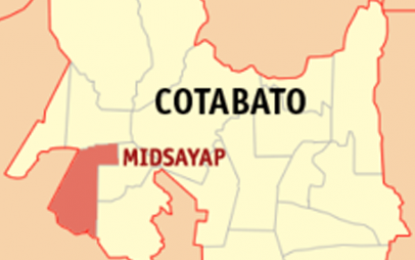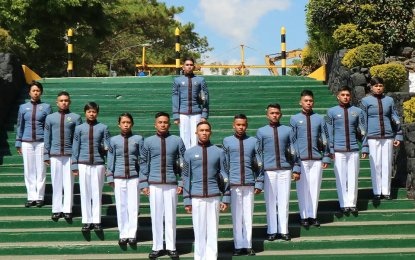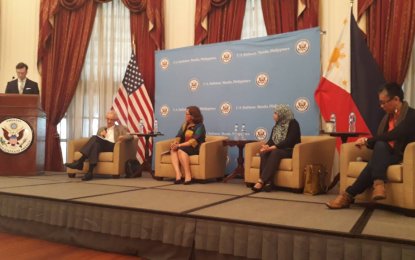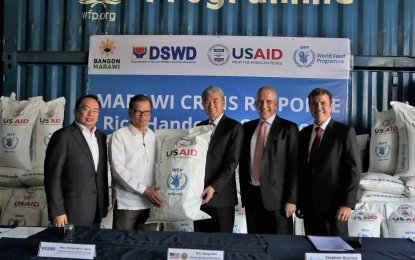From the Asia Times (Mar 12):
ISIS alive and well in the Philippines
New military-militant clashes show Islamic State's local affiliates have regrouped and spread since last year's siege of Marawi
 Abandoned house vandalized with "I LOVE ISIS" graffiti in Marawi, southern Philippines on June 9, 2017. Photo: NurPhoto via AFP/Richard Atrero de Guzman
Abandoned house vandalized with "I LOVE ISIS" graffiti in Marawi, southern Philippines on June 9, 2017. Photo: NurPhoto via AFP/Richard Atrero de Guzman
Almost five months after Philippine troops flushed out Islamic State-aligned militants in the southern city of Marawi, fierce clashes erupted anew in restive Maguindanao province, leaving 44 Islamic militants killed, according to the military.
The dead — although their number could not be independently verified — belonged to the Bangsamoro Islamic Freedom Fighters (BIFF), which like the Maute Group that laid siege to Marawi in May 2017, had pledged allegiance to the Islamic State.
To be sure, BIFF members did not deliberately attack troops who were on martial law-related clearing operations in Maguindanao, a next possible flashpoint for an Islamic State-inspired uprising on the southern island of Mindanao.
On March 8, 2nd Mechanized Infantry Battalion troops under the army’s battle-tested 6th Infantry Division chanced upon an initial 50 BIFF members in the swamplands of Datu Saudi Ampatuan, some five hours away from Marawi by car.
According to the military, 26 more BIFF fighters were wounded, with only one injured from the army, in fighting that caused thousands of civilians to take flight to safer areas.
“The firefight was so intense. Our troops pounded them with heavy fires,” said Lieutenant Colonel Alvin Iyog. “They ran for their lives leaving behind improvised explosive devices, high-powered firearms, ammunition, and personal belongings stained with blood,” he claimed.
 Soldiers stand guard in Mapandi village, Marawi City, June 2, 2017. REUTERS/Romeo Ranoco – RTX38N4D
Soldiers stand guard in Mapandi village, Marawi City, June 2, 2017. REUTERS/Romeo Ranoco – RTX38N4DTroops also reportedly recovered a black Islamic State flag during offensives that saw the military use aerial bombings and artillery strikes. The militants were reportedly reinforced with help from nearby communities.
The fresh clashes between the military and BIFF came days before the Autonomous Region in Muslim Mindanao (ARMM) observed the “Bangsamoro Week of Peace” on March 12, with the theme “Hope and Solidarity in Struggle.”
The ARMM straddles five provinces all infiltrated by Islamic State-aligned militants— the BIFF and the Maute Group in Maguindanao and Lanao del Sur in the mainland, and the Abu Sayyaf Group in the island provinces of Basilan, Sulu and Tawi-Tawi.
For over four decades, various iterations of the Moro rebellion aimed at Muslim self-rule left the region impoverished, with governance changing hands among a few wealthy dynastic families.
Security analyst Rommel Banlaoi, chair of the Philippine Institute for Peace, Violence and Terrorism Research, noted that while the fresh firefight in Maguindanao was an offshoot of a regular military operation, threats from Islamic State-inspired militants remained real.
“Mindanao, particularly the ARMM, is deeply penetrated by ISIS Philippines,” Banlaoi told Asia Times.
 Weapons and ISIS flags recovered from a militant group allied to the terror group in Sultan Kudarat province, Mindanao, in a file photo. Photo: AFP/Stringer
Weapons and ISIS flags recovered from a militant group allied to the terror group in Sultan Kudarat province, Mindanao, in a file photo. Photo: AFP/StringerLast month, the United States declared ISIS Philippines, reputedly composed of 23 armed groups mainly based in Mindanao, including the BIFF, as a foreign terrorist organization.
Following the liberation of Marawi from the Maute Group in October 2017, populist President Rodrigo Duterte admitted that Islamic State-affiliated militants were still actively recruiting and regrouping to sustain their drive to establish a caliphate in Southeast Asia.
Duterte, who placed the entire Mindanao under martial law in the wake of the Marawi siege and later extended the rights-curbing measure through December 2018, has also warned that Islamic militants and their supporters would avenge their defeat at Marawi, including through possible lone wolf attacks on key cities across the country.
Abu Sayyaf leader Isnilon Hapilon, the designated Islamic State emir in Southeast Asia, and two key Maute brothers who led the Marawi siege, were among the 1,100 mostly militants killed during the five-month war that left the city in shambles.
Last week, a military official in Mindanao announced that Abu Dar has succeeded Hapilon as the new Islamic State emir in Southeast Asia. The new emir, a full-blooded Maranao from Lanao del Sur, was reportedly among those who plotted the Marawi siege.
Banlaoi said “it will be very difficult at present for ISIS Philippines to mount a siege similar to Marawi elsewhere in Mindanao,” even with a new emir.
 Philippine President Rodrigo Duterte gestures while delivering a speech during a visit to Marawi city, southern Philippines, October 17, 2017. Reuters/Stringer
Philippine President Rodrigo Duterte gestures while delivering a speech during a visit to Marawi city, southern Philippines, October 17, 2017. Reuters/StringerBut the security analyst also warned that ISIS Philippines has capabilities to launch intermittent bombings and other violent activities anywhere in the Philippines.
Islamic militants also continue to attract new recruits using assets looted during the Marawi siege, capitalizing on the inherent distrust of the Moro people against the government and on the slow pace of rehabilitation in Marawi. The reconstruction of the city’s ground zero are is yet to commence.
“ISIS Philippines is discreetly recruiting members like wild fire and it has established strong sleeper cells in key vulnerable cities in Mindanao,” Banlaoi claimed.
The BIFF, which is among the 23 armed groups said to compose ISIS Philippines, has launched guerilla-like attacks on military installations in Maguindanao even while troops were busy in Marawi last year, apparently to distract military attention.
If 44 BIFF fighters were indeed killed over the weekend, as the military has claimed, it would represent the rebel group’s biggest single loss since it broke away from the Moro Islamic Liberation Front (MILF) in 2010 due to ideological differences.
The MILF is the largest Moro rebel group in the country. It forged a final peace agreement with the government in 2014, the same year the breakaway BIFF pledged allegiance to Islamic State.

Under the peace accord, the MILF opted for greater autonomy, which the BIFF opposed as they want to establish an independent Islamic state in the south.
MILF chair Al Haj Murad Ebrahim noted that one of the key antidotes to defeating the spread of violent Islamic State ideology is to implement the peace accord through the passage of the law that replaces the ARMM with a new Bangsamoro region.
He recently told foreign correspondents in Manila that foreign Islamic State fighters forced out of Syria and Iraq have been arriving in the southern Philippines to propagate their agenda.
Another MILF leader, Mohagher Iqbal, said that a faction of the BIFF is coddling foreign Islamic State fighters.
Defense Secretary Delfin Lorenzana did not deny that foreign Islamic State fighters have been arriving in the southern Philippines, even after Marawi’s liberation.
 Philippine Defense Secretary Delfin Lorenzana (C) tries a M4 rifle donated by China’s government at military headquarters, Manila, October 5, 2017. Photo: AFP/Ted Aljibe
Philippine Defense Secretary Delfin Lorenzana (C) tries a M4 rifle donated by China’s government at military headquarters, Manila, October 5, 2017. Photo: AFP/Ted AljibeHe said officials are verifying reports that militants from Indonesia and Malaysia, both of which sent fighters to Syria and Iraq, are leveraging vast and porous maritime borders to enter Mindanao and spread Islamic State ideology, both locally and throughout Southeast Asia.
Malaysian and Indonesian fighters were confirmed to have joined the Marawi siege last year.
Major General Arnel dela Vega, 6th Infantry Division commander, said intelligence information shows that the BIFF is consolidating its forces in the region, seen in the fresh clashes over the weekend.
“(We are) very determined to defeat the threat group and thwart them from doing terroristic activities in Central Mindanao,” the military official said. While that may be the case, it’s also clear the threat is fast spreading across a wider geography.
http://www.atimes.com/article/isis-alive-well-philippines/














